
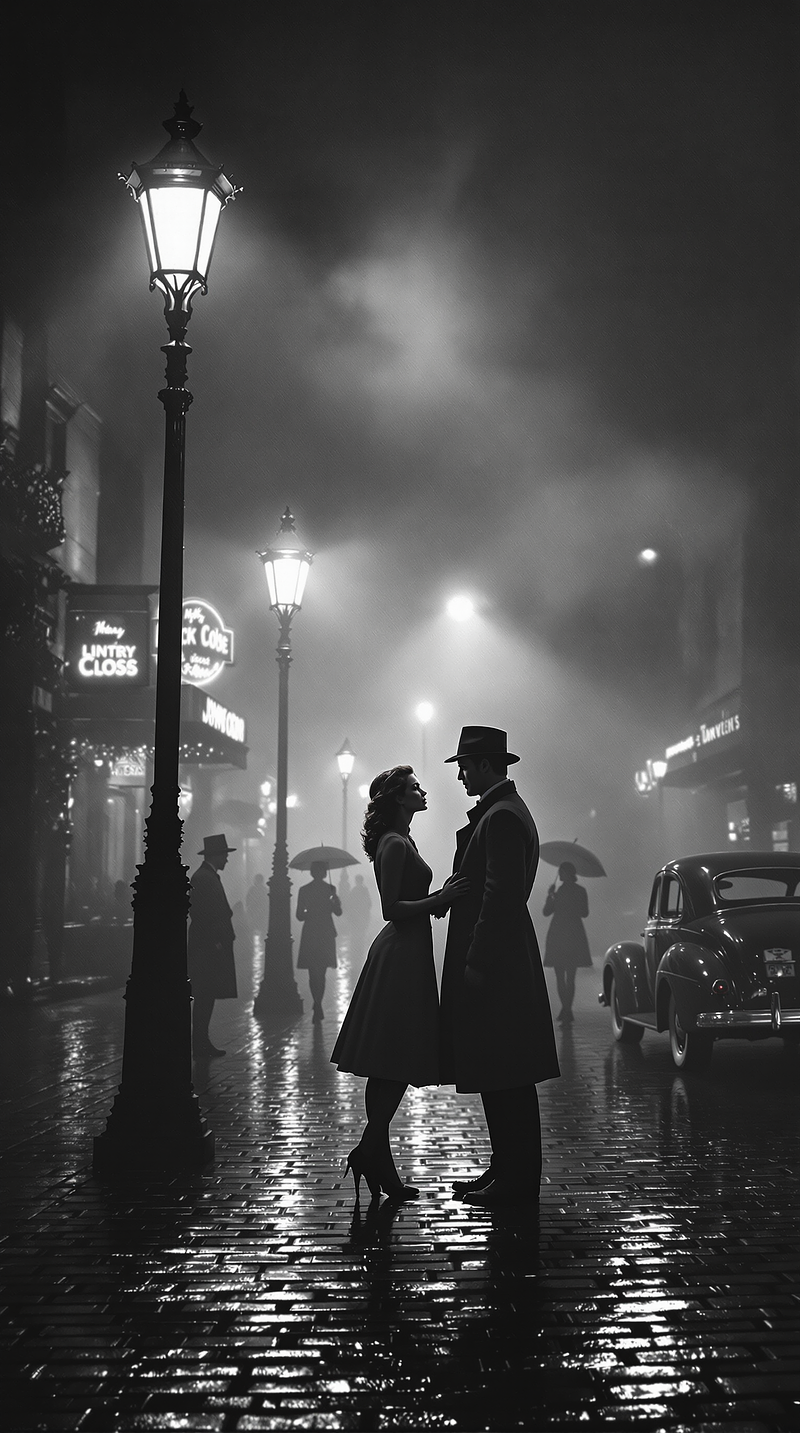
Prompt by Pulsar212121
on cobblestone street prompts
hundreds of results

hundreds of results

8 months ago
An eerie and mysterious Victorian street scene in Richmond, London, shrouded in thick fog. Gas lamps flicker dimly, casting long, distorted shadows across cobblestones. The atmosphere is haunting, with dark alleyways vanishing into the mist. A faint silhouette of a female figure lingers ominously, adding to the sense of dread. Rendered in a Penny Dreadful comic style with dramatic contrasts, deep shadows, and intricate Victorian architectural details, the scene evokes a chilling and suspenseful mood.

7 months ago
Abstract Full-Body Portrait of a Prostitute – Salvador Dalí (Late-Life Style, Singular Focus & Pure Surrealism) (Surrealism:1.7, Salvador Dalí late-life style:2.0, Dreamlike distortion:1.6, Hyperreal textures:1.5, Chiaroscuro contrast:1.4, Oil-painting brushstrokes:1.5, Organic fluidity:1.6, Metaphysical realism:1.4) A full-body surrealist portrait of a prostitute, painted in the unmistakable late-life style of Salvador Dalí, where dream logic dictates form and reality bends into its own subconscious reflection. She stands alone in the void, a lone figure frozen in motion yet melting into time itself. Her body is elongated but coherent, her limbs refined into one singular, fluid, organic motion, as if she is a sculpture made of half-formed candle wax, melting at the edges but never fully dissolving. Her face remains untouched by distortion, hyperreal and melancholic, eyes darkened with kohl, staring directly outward, unblinking, as if confronting time, fate, and the fabric of reality itself. A single strand of jet-black hair escapes from her carefully pinned curls, swaying in an invisible breeze. Her lips—painted a deep, blood-red—drip slightly at the edges, as if smeared by unseen hands, caught between seduction and sorrow. Her dress, a relic of the past, is a contradiction of luxury and decay, the hem transforming into thin wisps of smoke, curling and dispersing into the canvas. The fabric is stretched unnaturally, its folds elongating like the melted forms of Dalí’s classic clocks, one shoulder slipping in an eternal descent, never quite falling. The setting is an infinite, surreal landscape—a lonely street with no visible end, where shadows stretch longer than their owners, and the cobblestones appear to melt into liquid mercury. In the background, a large, antique pocket watch, twisted and partially submerged in the air, hangs frozen at an uncertain hour, its hands warped into elongated spirals. A single red rose, impossibly large and impossibly alive, hovers just behind her, its petals peeling away like fragments of forgotten love letters. The air feels thick, painted with visible brushstrokes, where light and shadow do not obey the laws of physics—instead, they bleed into one another, wrapping around her body in soft, liquid chiaroscuro, mimicking the curvature of a dream. She is not merely a woman but a symbol—of desire, of loss, of something slipping through time like sand through Dalí’s own fingers.

9 months ago
a cinematic black-and-white noir depiction of a vintage cobblestone street at night, shrouded in thick, atmospheric fog. Old-fashioned lampposts line the street, their soft, glowing light diffusing through the mist and casting elongated shadows that ripple faintly on the wet cobblestones. The reflections glimmer, adding texture and depth to the scene. Under one of the glowing streetlamps, a man in a trench coat and fedora leans slightly toward a woman in a classic 1940s dress. Her elegant silhouette is illuminated by the soft light, creating a captivating focal point amidst the hazy surroundings. Their body language suggests a quiet but intense exchange, adding an air of mystery and intrigue. In the background, additional figures holding umbrellas move through the fog, their outlines blending seamlessly into the moody atmosphere. A vintage car is parked further down the street, its polished surface reflecting the lamplight and adding to the period authenticity. The faint outlines of nearby buildings and shopfronts emerge through the mist, enhancing the depth and realism of the setting. The scene is rendered in intricate detail, with a focus on the interplay of light and shadow, capturing the glistening textures of the cobblestones, the folds of the woman’s dress, and the subtle highlights on the man’s fedora. The overall composition exudes the essence of classic noir, immersing the viewer in a mysterious, cinematic moment filled with drama and elegance.
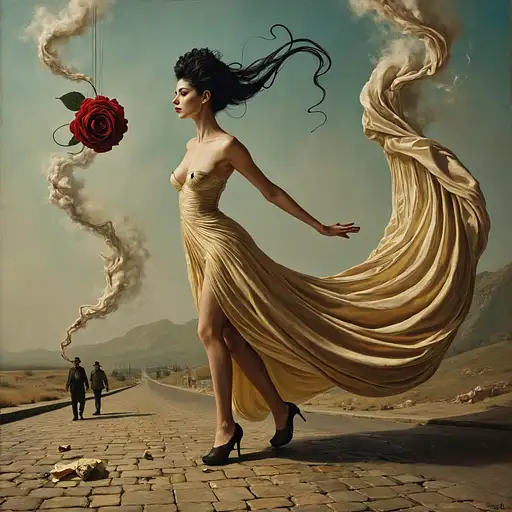
7 months ago
(Surrealism:1.7, Salvador Dalí late-life style:2.0, Dreamlike distortion:1.6, Hyperreal textures:1.5, Chiaroscuro contrast:1.4, Oil-painting brushstrokes:1.5, Organic fluidity:1.6, Metaphysical realism:1.4) A full-body surrealist portrait of a prostitute, painted in the unmistakable late-life style of Salvador Dalí, where dream logic dictates form and reality bends into its own subconscious reflection. She stands alone in the void, a lone figure frozen in motion yet melting into time itself. Her body is elongated but coherent, her limbs refined into one singular, fluid, organic motion, as if she is a sculpture made of half-formed candle wax, melting at the edges but never fully dissolving. Her face remains untouched by distortion, hyperreal and melancholic, eyes darkened with kohl, staring directly outward, unblinking, as if confronting time, fate, and the fabric of reality itself. A single strand of jet-black hair escapes from her carefully pinned curls, swaying in an invisible breeze. Her lips—painted a deep, blood-red—drip slightly at the edges, as if smeared by unseen hands, caught between seduction and sorrow. Her dress, a relic of the past, is a contradiction of luxury and decay, the hem transforming into thin wisps of smoke, curling and dispersing into the canvas. The fabric is stretched unnaturally, its folds elongating like the melted forms of Dalí’s classic clocks, one shoulder slipping in an eternal descent, never quite falling. The setting is an infinite, surreal landscape—a lonely street with no visible end, where shadows stretch longer than their owners, and the cobblestones appear to melt into liquid mercury. In the background, a large, antique pocket watch, twisted and partially submerged in the air, hangs frozen at an uncertain hour, its hands warped into elongated spirals. A single red rose, impossibly large and impossibly alive, hovers just behind her, its petals peeling away like fragments of forgotten love letters. The air feels thick, painted with visible brushstrokes, where light and shadow do not obey the laws of physics—instead, they bleed into one another, wrapping around her body in soft, liquid chiaroscuro, mimicking the curvature of a dream. She is not merely a woman but a symbol—of desire, of loss, of something slipping through time like sand through Dalí’s own fingers.

4 months ago
The main subject is an African American woman with long, voluminous, wavy red-orange hair. Her skin appears smooth with a dark brown complexion. She has large, dark eyes with long eyelashes, a small nose, and full lips painted with a bright red lipstick. Her expression is confident and engaging. Her face is somewhat heart shaped. She is slender with a noticeable curve at the waist and hips. She is standing upright, holding a purse in her right hand, and her left hand placed on her left hip. She is wearing a fitted, short-sleeved purple dress that ends above the knee. Around her neck is a light green silk scarf secured with three decorative gold pins featuring peace symbols. She is carrying a small, quilted, light beige purse with a gold chain strap. Gold bracelets are visible on her left wrist. In the background, a man in a dark suit is walking away from the camera to the right. He appears to have short, light hair and a medium body build, walking with a casual but alert posture. The background depicts a winding cobblestone street between two buildings of a historic German village, casting a warm, golden light across its surface as the sun begins to set behind the buildings. Trees cast dark shadows against the light of the sky that frames the half-timbered houses. The buildings themselves are a showcase of medieval architecture, featuring dark wood beams and whitewashed or yellow walls, with potted plants and greenery adorning the front of one building. The cobblestone street is uneven and worn, adding to the rustic charm of the scene.
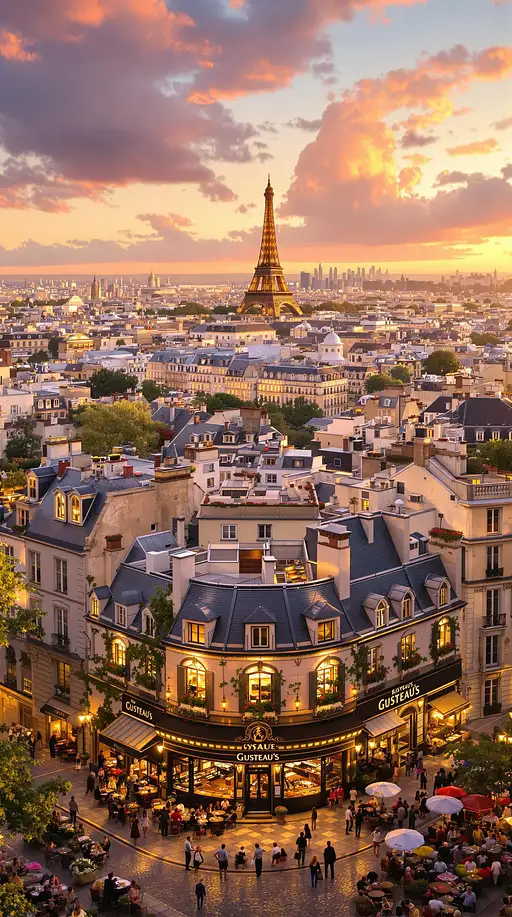
7 months ago
Breathtaking panoramic view of Paris inspired by Ratatouille; golden evening light over iconic cityscape with Eiffel Tower visible; charming Parisian streets with bustling cafés and restaurants; prestigious Gusteau's restaurant with elegant facade and warm lights; professional chefs visible through kitchen windows; authentic French architectural details and cobblestone streets; people dining at outdoor tables with authentic cuisine; patisserie displays with colorful macarons and delicate pastries; absolutely no cartoon elements; completely realistic cinematic photography; natural lighting creating romantic Parisian atmosphere; hyper-detailed urban environment capturing both the high cuisine world and everyday Paris life --ar 16:9 --v 6.1

6 months ago
A hyperrealistic, exquisite photo of an unexpected moment caught perfectly: Along the sun-drenched shores of Santorini, where pristine white buildings and cobalt domes meet the endless Aegean Sea, a colossal hand appears against a clear blue sky flecked with soft, cottony clouds. This giant hand, with its lifelike texture and subtle shadows, holds an oversized ice cream cone piled high with pastel-hued scoops. In a moment of delightful absurdity, the hand tilts the cone, allowing a cascade of melting ice cream to flow gracefully over the terracotta rooftops of the picturesque village below. The sweet, slowly dripping cascade creates intricate patterns on the ancient walls, which shimmer under the gentle summer-spring light. Along the narrow cobblestone streets, locals and tourists alike--clad in breezy summer clothes--gawk in stunned amusement, their faces reflecting a blend of shock and childlike delight. Every element of the scene, from the delicate texture of the melting ice cream to the intricate details of the village architecture, is rendered in exquisite photorealistic detail, turning an ordinary Mediterranean day into a surreal celebration of whimsy and flavor.

6 months ago
Create a hyperrealistic painting in the style of Caspar David Friedrich. Depict a snow-covered cobblestone street in a quaint 19th-century Austrian mountain town. At the center, embed a shimmering, ethereal portal revealing a dark, misty, otherworldly landscape. An 18-year-old Austrian man with fair skin, dark hair, and intense blue eyes desperately pulls at the portal's edge, his body low and strained, wearing a textured dark brown loden coat and worn leather boots. Inside the portal, his 19-year-old girlfriend with olive skin, long dark curly hair, and piercing green eyes appears trapped, her form obscured by swirling mist, wearing a flowing crimson velvet dress. Use dramatic lighting: a cool, bluish light illuminates the snowy town, contrasting with the deep shadows of the portal's realm. Employ a cinematic wide shot to emphasize the scale of the supernatural event, blending realism with magical realism to capture the scene's awe and terror.

6 months ago
full body Masking, Custom Brush Creation drawing of a 24-year-old Guatemalan female fierce martial artist with a warm and inviting expression. She has Soft, ivory skin that shows a slight pinkish hue, especially in cold weather. The skin pores and texture are clearly visible and in focus. Her Long, horizontal oval eyes, Twinkling, topaz eyes, framed by long, elegant eyelashes. Her haircut is Umbrian Upswept - Short back with longer crown layers. Her eyebrows are neatly shaped, complementing her delicate facial features. Her body is Sleek, toned upper chest with smooth, defined lines, small breast, toned abs, Female Bodybuilding style. She wears a cropped Fur-trimmed cropped cardigan, midriff, a lowrise High-waisted pencil skirt with contrast stitching. She poses Standing with one arm extended as if reaching for something. She is positioned on the left side in the frame by the rule of thirds. In the background Foggy medieval street with gas lamps and cobblestone paths. The scene is lighted Muted overcast light with a dreamy softness. the model is lighted with soft natural lighting in the style of Milo Manara
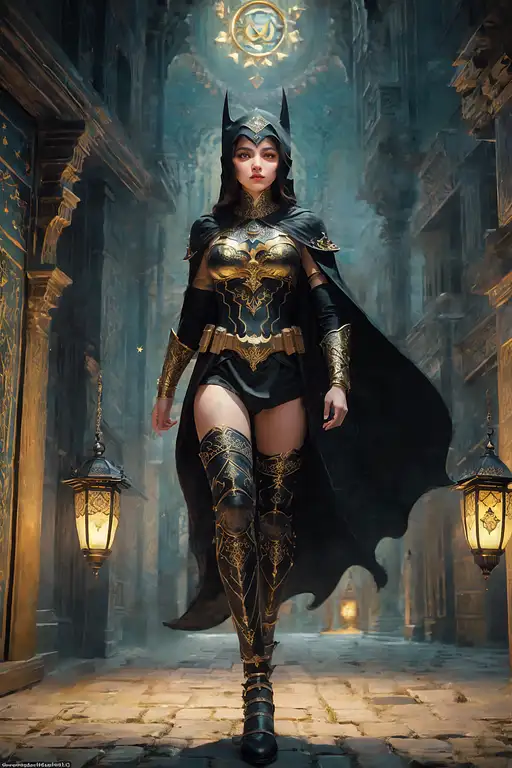
3 months ago
Full-body Batman, Oriental style, minimal detailing, dark flowing cape with intricate Middle Eastern patterns (1.4), dynamic pose with one foot forward, body slightly angled, cape billowing in the wind. Starlit Arabian night, narrow dark alley bathed in soft moonlight (1.5), streets lined with old Arabian architecture (1.5) â intricate arches, ornate stone walls with faint Arabic patterns (1.4). Volumetric haze and ambient fog (1.5) illuminated by stars and dimly lit brass lanterns (1.3) hanging from buildings, dusty cobblestone ground reflecting the warm lantern glow. Batmanâs cape with hints of gold embroidery (1.2), adding a mystical, exotic aura. Golden threads visible under soft starlight, with subtle designs inspired by 17th-century Arabian armor, powerful and graceful stance, glowing eyes piercing through haze, calm and resolute. Cinematic ambiance: volumetric smoke (1.6) from a nearby brazier, moonlight, and soft lantern glow (1.4), intricate Arabic architecture (1.5), arches and detailed carvings forming a striking background.

9 months ago
a cinematic black-and-white noir depiction of a vintage cobblestone street at night, drenched in a moody, atmospheric fog. The soft glow of lampposts illuminates the scene, their light diffusing through the thick mist and casting long, dramatic shadows. A man in a trench coat and fedora leans in to speak with a woman standing under a streetlamp, her striking 1940s-style dress glowing in vibrant red—the only color in the monochrome scene, creating a dramatic and captivating focal point. The woman's red dress is elegantly detailed, with flowing fabric and a classic silhouette that exudes vintage glamour. The man, in stark contrast, is clad in a shadowy trench coat and a dark fedora, his figure partially obscured by the fog. Their postures suggest an intense or intimate exchange, adding an air of intrigue and mystery. The background reveals blurred figures holding umbrellas, their forms blending into the misty atmosphere, along with vintage cars parked along the cobblestone street. The reflections of lamplight shimmer softly on the wet stones, adding depth and texture to the scene. The interplay of light and shadow enhances the noir aesthetic, with strong contrasts highlighting the textures of the cobblestones, the folds of the dress, and the contours of the characters. The overall composition captures the essence of a classic noir film, evoking a sense of romance, mystery, and drama in a richly textured and meticulously detailed setting. Rendered with a focus on mood, atmosphere, and visual storytelling, this image seamlessly blends vintage elegance with cinematic artistry.

9 months ago
joyful baby in tiny cardigan beside baby penguin in city setting, both giggling and same height, brownstone buildings, falling autumn leaves, street lamps, cobblestone street, golden hour light
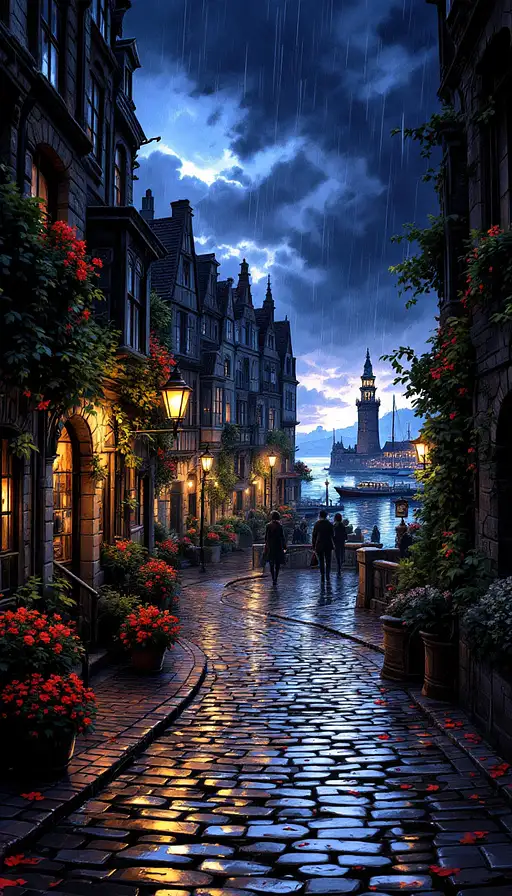
6 months ago
A captivating dark fantasy illustration of a picturesque European-style town during a rainy evening. Cobblestone streets wind through the town, lined with multi-storied buildings featuring historic charm, stone exteriors, and ornate details. A vibrant alleyway on the left is adorned with red flowers in pots, while warm street lamps emit a cozy glow amidst the stormy sky. In the distance, the town stretches to a harbor, where boats are moored and a towering lighthouse stands defiantly against the turbulent sea. The scene is richly detailed and vividly alive, capturing the essence of a mysterious and enchanting world.

6 months ago
A wide, ethereal view of a forgotten Victorian town at twilight, drowned in swirling violet, silver, and deep blue mist. Broken cobblestone streets stretch into the distance, faintly glowing with soft, magical veins of light that weave across the ground. In the center of the misty scene, a crumbling, ancient stone bridge arches above a flooded, reflective street. A lone spectral figure cloaked in flowing mist slowly crosses the bridge, leaving behind shimmering ripples of pale golden light. The abandoned Victorian houses loom through the fog with ornate rooftops and leaning towers, their windows dark. Distant ruined spires barely pierce the dense twilight sky. The mist glows faintly where the spectral figure moves, as if reality itself parts for them. The overall mood is sacred, dreamlike, melancholic, and ancient, blending Romantic painting textures with surreal fantasy atmosphere. Painterly brushstroke texture, soft lighting, cinematic depth of field, magical realism.
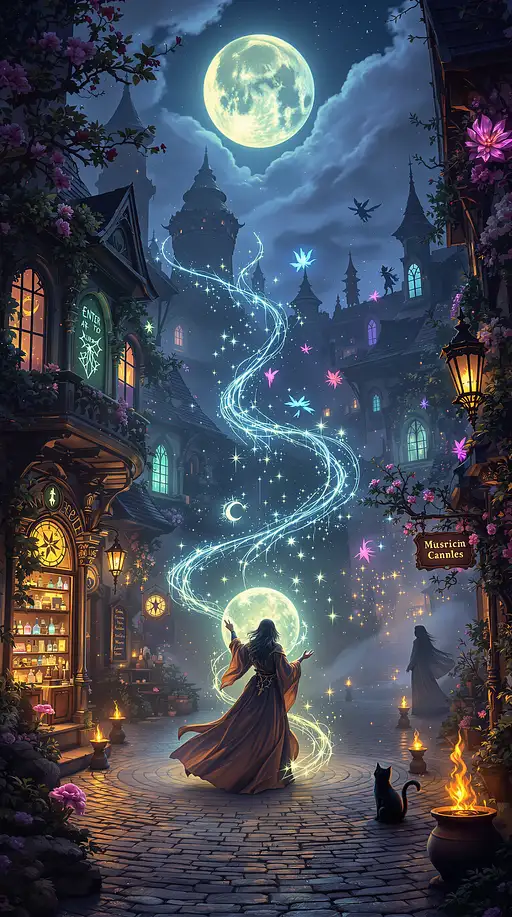
7 months ago
A **breathtaking, cinematic depiction** of a **mystical, moonlit world teeming with ancient and arcane magic**, where **every inch pulses with enchantment, wonder, and secrets waiting to be unveiled**. At the **heart of the scene**, a **powerful sorcerer**, draped in **flowing robes adorned with intricate glowing runes**, stands in the center of a **cobblestone street, conjuring a mesmerizing spell**. **Tendrils of luminous energy swirl through the air**, forming **intricate arcane symbols**, their **pulsing light casting an ethereal glow upon his face**. His **ornate staff, encrusted with glowing crystals, crackles with power**, while beside him, an **ancient floating tome levitates, its pages flipping on their own**, revealing **forbidden incantations that shimmer with raw magic**.

4 months ago
An elegant, dark-haired Italian man model, 35 years old, dressed in a white linen shirt with rolled-up sleeves, stands in a sun-drenched Italian piazza, holding a glass of vine. Cobblestone streets stretch out before him, lined with flowering vines and ancient architecture. He exudes an air of refined leisure and worldly sophistication. The scene is bathed in the warm, golden light of late afternoon. Rendered in a hyperrealistic style with flawless retouching and exquisite detail, reminiscent of a high-end fashion advertisement, capturing the essence of Italian elegance and the art of savoring life's simple pleasures. 8k resolution. Flawless retouching. Elegant atmosphere. Masterpiece. Exquisite details. High quality, full HD
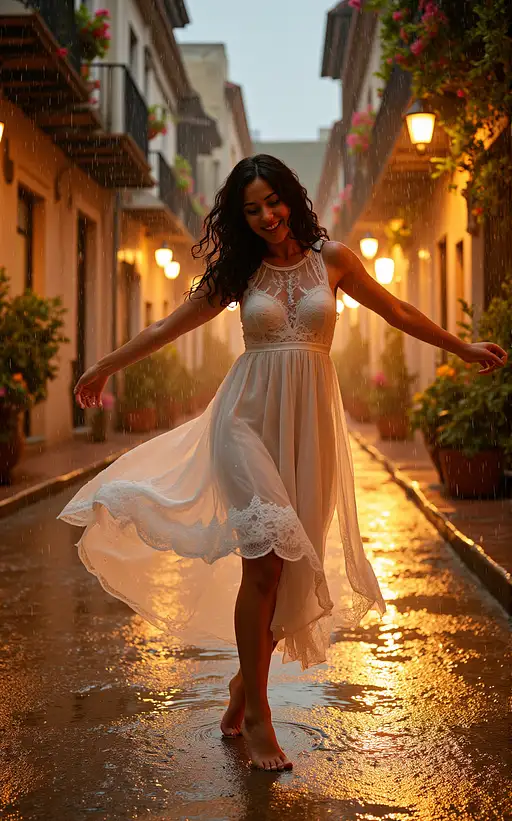
1 month ago
In the heart of an ancient Spanish city, a radiant woman dances with wild abandon under a torrential downpour, her joy as boundless as the rain itself. Her long, dark curls cling to her face and shoulders, framing her glowing features, while her slender, graceful figure moves with effortless elegance. She wears a flowing white dress, now translucent and clinging to her skin, its delicate lace sleeves and embroidered hem shimmering with raindrops. The dress sways around her as she twirls, her bare feet splashing in the glistening puddles that mirror the golden glow of nearby lanterns. Around her, the cobblestone street is deserted, lined with weathered buildings adorned with wrought-iron balconies and vibrant flower boxes. The rain blurs the distant glow of streetlights, creating a dreamy, misty atmosphere, while the scent of wet earth and petrichor fills the air. Every drop seems to celebrate her freedom, capturing a moment of pure, unfiltered happiness.

4 months ago
19th century Fachwerk houses in Quedlinburg, Germany,timberframed structures, cobblestone streets, historic town setting, late afternoon, high contrast

7 months ago
A romantic oil painting in the impasto style of Leonid Afremov, set on Spiegelgasse — a narrow, winding street in Vienna's old town. Rain glistens on the cobblestones, reflecting glowing amber lanterns and the soft golden light from café windows. A couple walks arm in arm under a red umbrella, their reflections shimmering below them in the puddles. The woman wears a flowing coat and scarf, the man in a classic dark trench, their figures warm and close in the cool, wet night. The tall, elegant buildings curve gently down the lane, their windows aglow with warmth. Vibrant flower boxes spill soft reds and purples into the night. The sky above is a deep, rainy blue — not stormy, but calm and introspective. Brushstrokes are bold and expressive, with thick texture capturing the dance of light and rain. The mood is cozy, hopeful, and full of romantic melancholy — a fleeting moment of beauty in a quiet Viennese rain.

4 months ago
A woman sunbathes on a tiny balcony, the warm sunlight streaming through the railing's intricate details and onto her skin. Her eyes are closed, her face tilted upwards towards the heavens as she soaks up the golden rays. An inverted bob haircut frames her features, with every detail of her natural skin visible to the naked eye - including the subtle texture of her pores. A thin dress in a floral pattern clings to her curves, adding a touch of elegance to the serene scene. The vintage balcony railing behind her is visible through the window, its intricate details reflected in the soft glass as the woman's shadow plays out across her skin. The narrow streets of the old town stretch out into the distance, their cobblestone pavement and ancient buildings blending seamlessly with the peaceful mood of the moment. Long shadows dance across her face, adding a touch of drama to the beautiful scene.
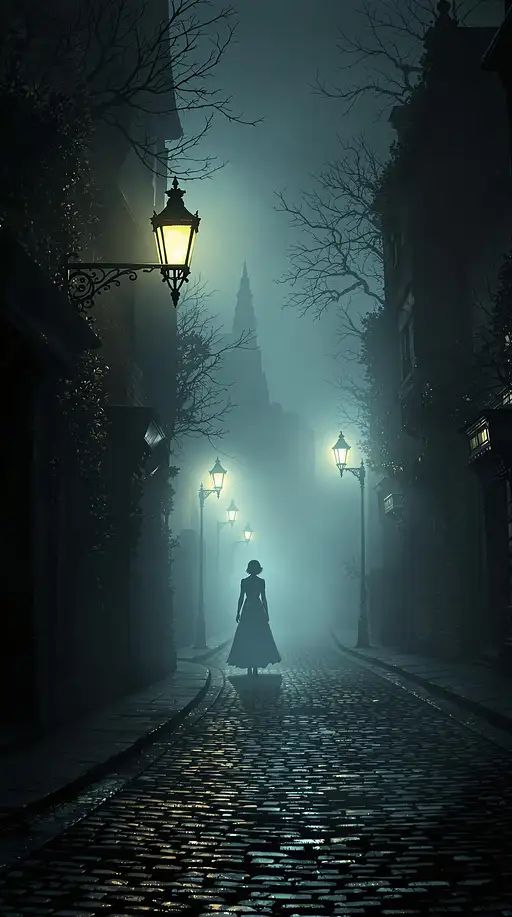
8 months ago
An eerie and mysterious Victorian street scene in Richmond, London, shrouded in thick fog. Gas lamps flicker dimly, casting long, distorted shadows across cobblestones. The atmosphere is haunting, with dark alleyways vanishing into the mist. A faint silhouette of a female figure lingers ominously, adding to the sense of dread. Rendered in a Penny Dreadful comic style with dramatic contrasts, deep shadows, and intricate Victorian architectural details, the scene evokes a chilling and suspenseful mood.
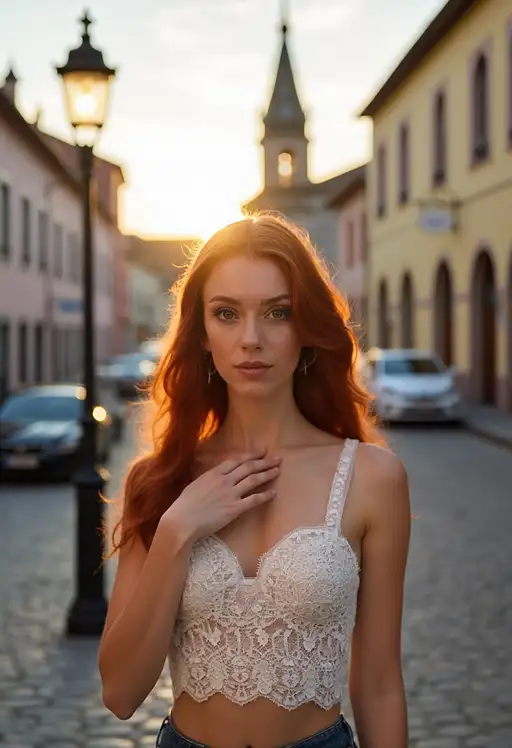
3 months ago
Create a professional photograph of a charming town square during golden hour, shot using a Fujifilm X-T4 camera with an 16-80mm f/2.8 lens at f/5.6 and ISO 200. The scene features traditional buildings with pastel-colored facades, some featuring arched doorways and windows, as the sun sets on the horizon behind them. A street lamp stands prominently in the foreground to the left side of the image, adding a touch of vintage charm. The square is paved with cobblestones, and there are parked cars along one side, giving the scene an authentic and inviting atmosphere. In the background, a church or tower rises above the buildings, contributing to the picturesque town setting. A woman with long red hair poses in front of this backdrop, wearing a white lace crop top with intricate detail, giving it an elegant yet casual look. Her hand gently touches her collarbone as she looks directly at the camera with a soft expression. To capture the woman's features and the details of her clothing in high detail, use a wide-aperture lens to create a shallow depth of field. Include subtle details such as the texture of her hair and the intricate detailing on her top to enhance the elegant yet casual feel of the scene.
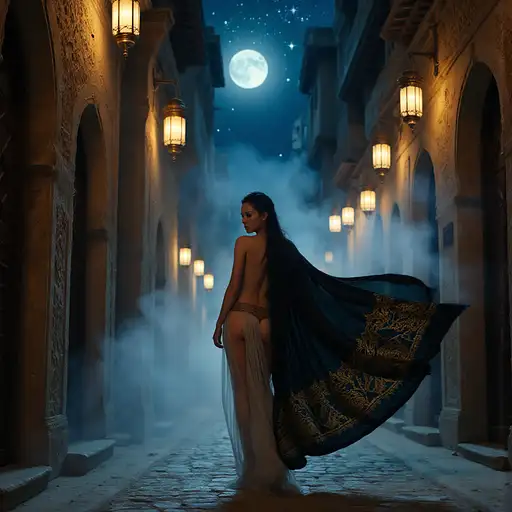
4 months ago
half (naked:1.6), woman wearing sheer robe Oriental style,dark flowing cape with intricate Middle Eastern patterns (1.4), dynamic pose with one foot forward, body slightly angled, cape billowing in the wind. Starlit Arabian night, narrow dark alley bathed in soft moonlight (1.5), streets lined with old Arabian architecture (1.5) â intricate arches, ornate stone walls with faint Arabic patterns (1.4). Volumetric haze and ambient fog (1.5) illuminated by stars and dimly lit brass lanterns (1.3) hanging from buildings, dusty cobblestone ground reflecting the warm lantern glow. cape with hints of gold embroidery (1.2), adding a mystical, exotic aura. Golden threads visible under soft starlight, with subtle designs inspired by 17th-century Arabian armor, powerful and graceful stance, glowing eyes piercing through haze, calm and resolute. Cinematic ambiance: volumetric smoke (1.6) from a nearby brazier, moonlight, and soft lantern glow (1.4), intricate Arabic architecture (1.5), arches and detailed carvings forming a striking background.

6 months ago
An eagle eye view of a Victorian town with a cobblestone street stretching infinitely into the night. The scene features rows upon rows of giant, vividly colored Victorian houses lining both sides of the street, creating a repeating, mirror-like pattern that extends into the far distance. The sky is perfectly black, offering a stark and dramatic contrast to the bright, warm lights emanating from the numerous windows of the towering houses. The cobblestone street reflects some of this light, adding depth and texture to the scene. The perspective emphasizes the infinite nature of the street, creating a disorienting and surreal visual effect. The overall atmosphere is eerie and dreamlike, with the stark contrast between the dark sky and the illuminated houses heightening the sense of unease and wonder. The Victorian architecture is detailed, with characteristic gables, bay windows, and ornate trim, all exaggerated in scale to contribute to the surreal and imposing nature of the environment. The lighting suggests a nighttime setting with artificial illumination from street lamps and house windows casting long, soft glows. The composition is symmetrical, emphasizing the repeating pattern and the infinite perspective.
Create a PromptHero account to save favorites, generate images, and discover AI artists you'll love.
Join a vibrant community of thousands of AI enthusiasts like you.
Already a member? Log in. By creating an account, you agree to our Terms Of Service, and to receive emails and updates.